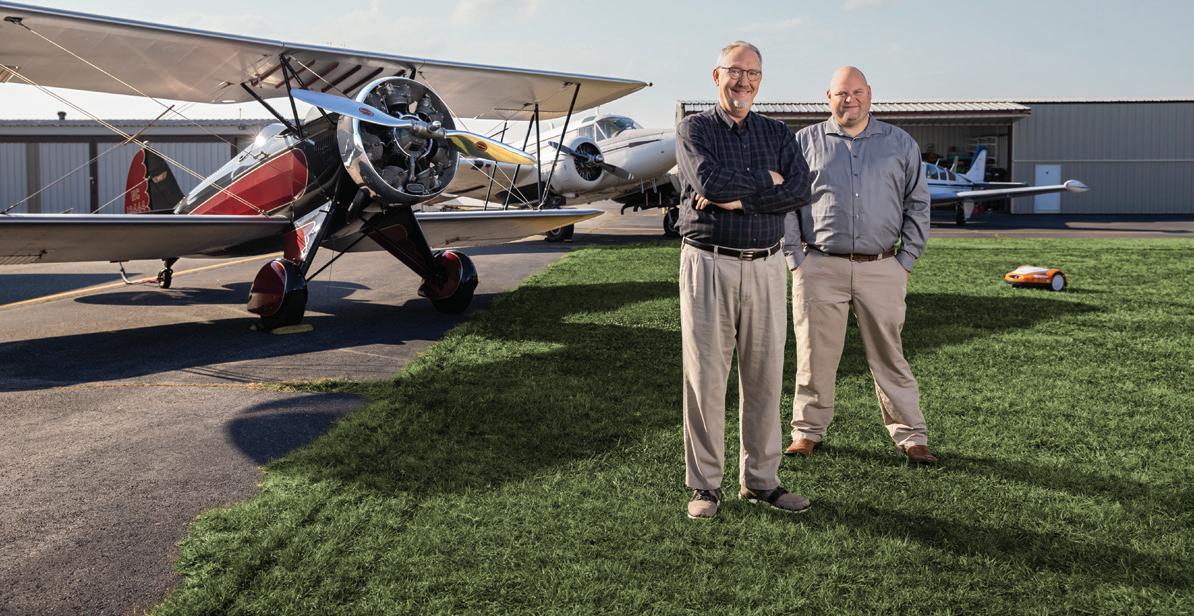
7 minute read
BUSINESS MANAGEMENT | SUCCESSION PLANNING 101
What to think about when it comes to succession planning.
Editor’s Note: This article is intended to help you understand the high-level decisions and considerations you’ll need to make. This is not tax or business financial advice and should not be taken as such. Consult with your tax adviser before making any decisions regarding the sale of your business.
Advertisement
You’re not going to work until you die of natural causes. And even if you did, you’d still need to make some plans for what happens to your business after you pass. To gain an expert’s perspective, I spoke with Khane Goodson, a certified financial planner with Citizen’s Bank.
Transition planning or succession planning?
Though many people use these terms interchangeably, they have different meanings in a business setting. Succession planning is defining what needs to happen internally to ensure a smooth transfer of ownership. Transition planning involves all the legalities of transferring business ownership from one person to another.
While they are different, they usually occur at the same time. If you’re going to pass the business to your children
@gustavofrazao - stock.adobe.com
or sell it to a third party, you’ll need to make internal, structural changes to the business (succession planning) while also consulting with your team about the legal and tax implications (transition planning).
Succession planning

“Internally, the owner or founder needs to work themselves out of a job,” says Goodson. When the business isn’t dependent on the owner, it’s more “turnkey” for a prospective buyer. Goodson says, “When the business isn’t dependent on the presence of the owner, it’s an investment. When it is dependent on the owner, the current owner isn’t selling an investment; they’re selling a job to the next owner.”
To “work yourself out of a job,” you need to start by listing all the duties that you currently have in the business. Don’t forget to include the ones that depend on you. For example, you may not deal with the marketing day to day, but the credit card used for Google Ad spending is the company card that’s in your name.
Once you have this list, identify the stuff you can delegate immediately. (Like that credit card; put it on your CEO’s company card instead.) Get as much off your plate as possible.
For things that you’re truly responsible for day to day, identify who you can train internally to take over those responsibilities. If it’s an adult child that you’re passing the business to, have them shadow you and learn what you do. If you’re planning to sell to a third party, see what responsibilities you can delegate to your C-suite and high-level managers. (Note: these people are probably already at capacity. Have them also find things they can delegate to others, so they have the bandwidth to take on your job duties.)
Transition planning
Some owners try to do this on their own. Don’t.
You should be working with a team of experts. Your transition planning team should include your CPA, attorney and insurance broker. You should include a commercial banker (in case a loan needs to happen to facilitate the purchase of the business) and a certified financial planner (CFP). “The benefit of working with a commercial banker is that they may be able to help with other resources, like a CFP,” says Goodson. There are many moving @Vitalii Vodolazskyi - stock.adobe.comparts in these transactions. You should work with a CFP to do some financial modeling and determine the best time to sell your business. Consulting with your CPA and attorney will help you determine how to maximize tax benefits. Some transactions require a life insurance policy to be taken out on both the buyer and the seller to offset the chance of any unfortunate disaster derailing the transaction and leaving everyone in the lurch.
When should I start planning?
“(Start planning) at least five years before you actually want to sell,” says Goodson. If you’ve taken any steps to try and lower your tax bracket, starting at least five years in advance will prevent any “red flags” from triggering an audit.
Consider transferring part ownership to your kids five or six years before you actually want to sell it. For example, if your company is currently worth $10 million and you transfer 20 percent ownership to your child, they’ll “own” $2 million.
If your modeling with your CFP shows that the company is going to double in value over the next five years, you’ll still be in a higher tax bracket (perhaps 35 to 40 percent), but that extra $2 million in company growth (from $2 million to $4 million) happened under your child’s “ownership.” They’ll likely be in a lower tax bracket (perhaps 25 to 30 percent), and you both will have saved the difference in taxes.
Succession planning and transition planning are pretty complicated processes that can take a long time. You should begin the process early, assemble a team of experts to walk you through the process and begin to “work yourself out of a job” as soon as you’ve identified the desire to sell.
Jay Worth Marketing Manager SingleOps
Khane Goodson CFP, Wealth Adviser Citizens Bank
AIRPORT SEES SKY-HIGH RESULTS WITH iMOW® ƒ

Chesapeake Regional Airport, an airport in coastal Virginia, sits on 500 acres with more than 80 hangars accommodating both private and commercial aircraft. While student pilots, commercial crews and hobbyists who frequent the airport are used to seeing the latest in aviation technology flying the skies above, the newest high-tech addition at this facility is operating on the ground.
CHALLENGES WITH PROPERTY MAINTENANCE
With a small staff responsible for the upkeep of the large property, the Chesapeake Regional Airport team’s conventional mower approach was causing more problems than solutions. Every time the grounds crew mowed the overgrown lawn, it resulted in grass clippings, dust and dirt blowing into the air. In addition, with a recent mechanical failure of their current mower, it was time for an upgrade. “When our crew was left without their primary means to maintain the property, we identified the opportunity to install STIHL iMOW® robotic mowers as a solution,” said Chris Schrantz, Airport Manager.
CLEAN, WELL-MAINTAINED LAWNS
Two STIHL RMI 632 PC-L iMOW® robotic mowers were installed to maintain approximately one acre each alongside rows of hangars housing aviation tenants. Unlike the conventional mowers, with STIHL iMOW®, there was no dust, dirt or excessive debris. Not only did the robotic mowers leave the area cleaner, but iMOW® also provided other benefits. The mowers’ self-mulching functionality returned nutrients and moisture back to the soil providing a greener, healthier lawn. Its smart battery technology automated the mowing work reducing labor, maintenance and fuel costs — saving the airport time and money.
LESS COST, LESS LABOR, HEALTHIER GRASS
With LTE connectivity the RMI 632 PC-L robotic mowers deliver a host of enhanced smart features — all operable via an app. From setting and updating mowing schedules to monitoring service issues and performance, usage has been seamless. According to Greg Dorson, Grounds Maintenance Lead, his experience with STIHL iMOW® has been “super easy,” he added. “It’s practically self-explanatory. In fact, one of the greatest benefits is that I don’t have to do the mowing — and it requires virtually zero maintenance.”

bottom-line results
iMOW® provides real solutions to challenges faced by the airport authority and other customers. Instead of mowing lawns, they can now focus on other more pressing tasks, and as an added benefit, the lawns maintained by iMOW® are green and thriving. “[Installing] STIHL iMOW® was a fantastic decision — and one that has paid off,” said Schrantz. “Over a five-month period, we’ve calculated only $5.75 in electricity costs per unit.1 A conventional solution would have taken double that amount in labor alone. Add wear and tear on our zero-turn mower plus fuel costs and it is a no-brainer!” Between labor and fuel costs, Chesapeake Regional Airport is saving upwards of $80 per month by using the two robotic mowers.
THE FUTURE OF MOWING
With the overwhelming success of the first two installations, a third iMOW® was installed to further reduce the grounds crew’s workload. Given the expanse of the property and the ROI analysis thus far, the Chesapeake Regional Airport is considering installing even more iMOW® robotic mowers onsite. “From the management side of things, iMOW® just makes a lot of good sense,” said Schrantz, “Especially for large-scale commercial applications. It’s just a great highly-efficient solution.” To learn more about the STIHL iMOW® visit STIHLUSA.com/









